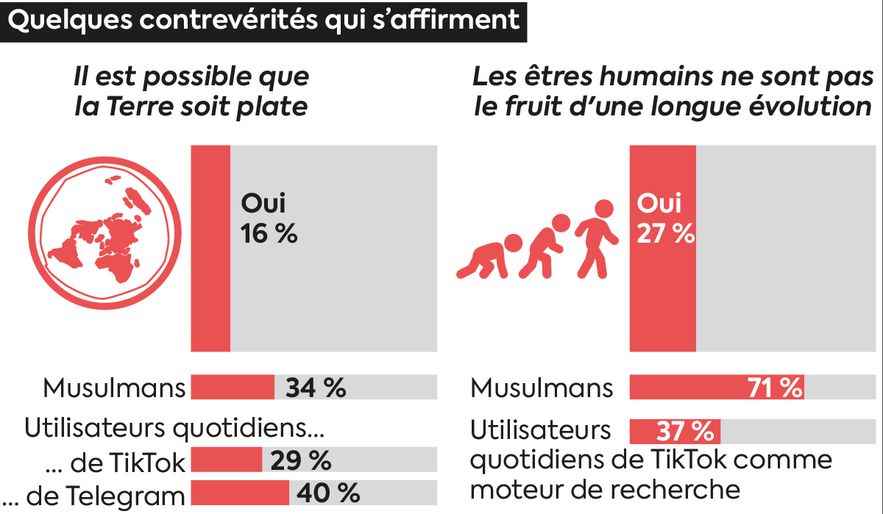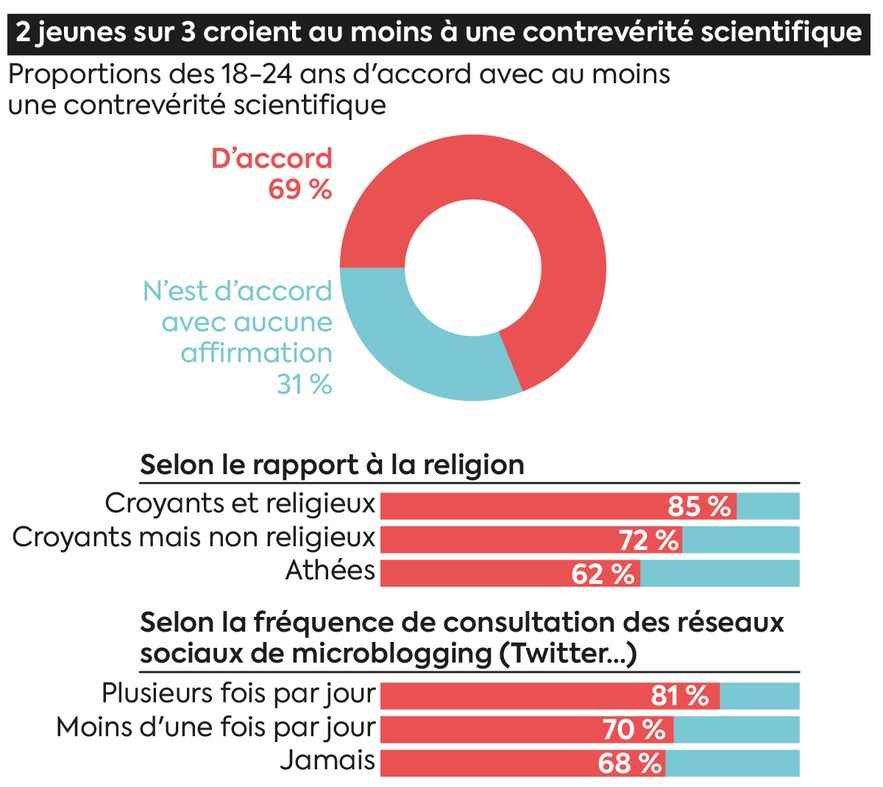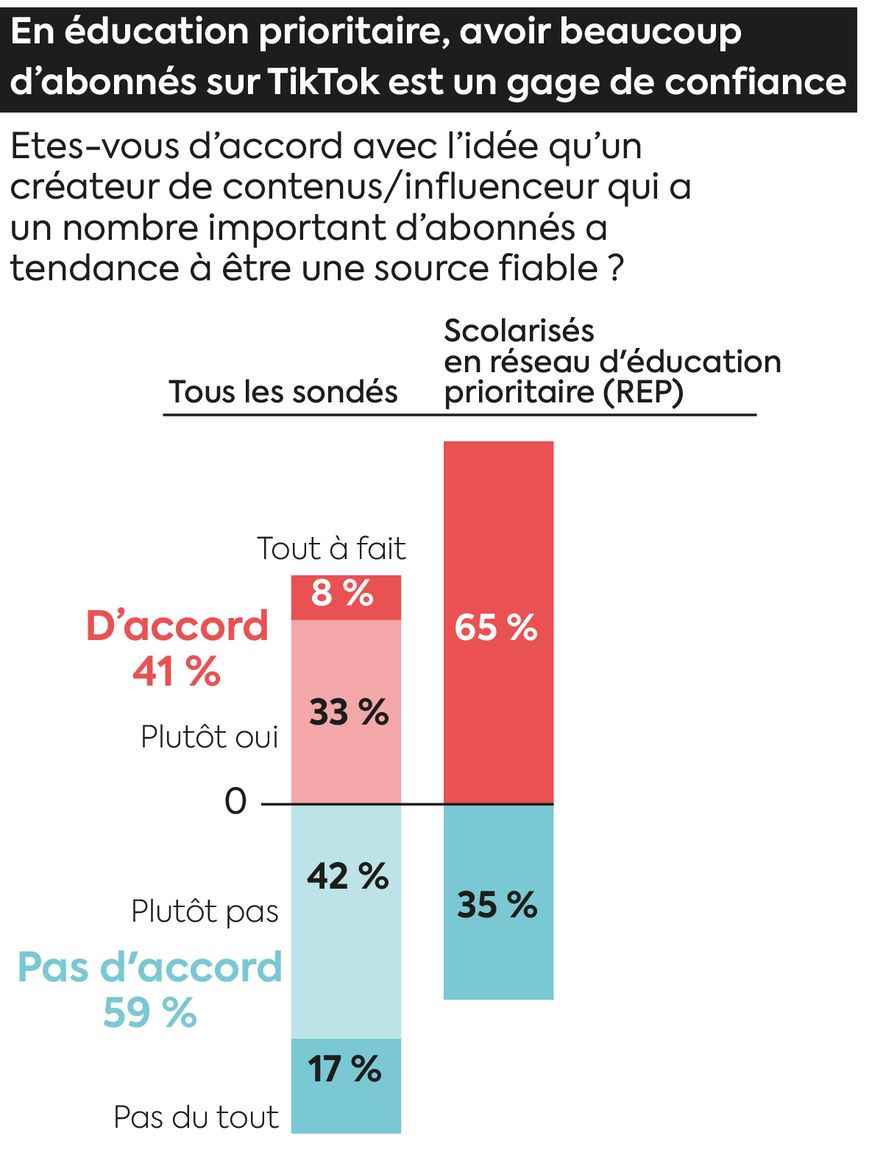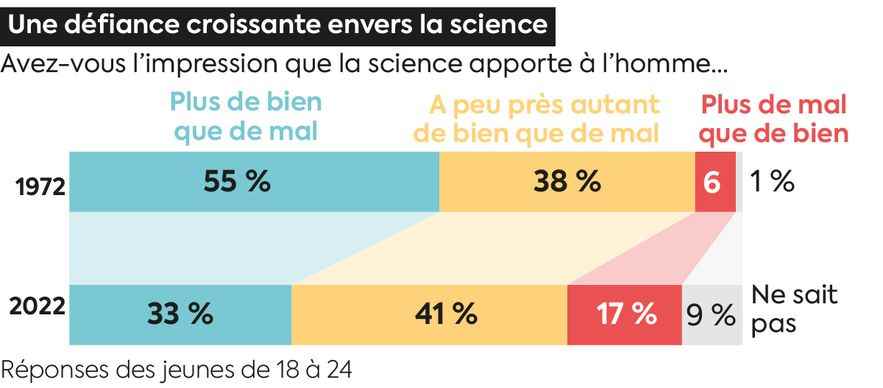An edifying development among young people: in 1972, 55% of 18-24 year olds believed that science brought more good than harm. In 2022, this proportion fell to 22%, a drop of 33 points. Symmetrically, the proportion that considers science to be more harmful to humanity has tripled, rising from 6% to 17% in fifty years.
For Generation Z, “the truth is elsewhere”, as the series titled it X Files launched in 1993. Since then, there has been an explosion of social networks, a loss of credibility among those in the know, a decline in traditional media in favor of influencers whose credibility is, among young people, measured by the yardstick of their audience .
A study carried out by Ifop for the Reboot Foundation and the Jean-Jaurès Foundation reveals an unprecedented weakening of scientific references among 18-24 year olds (the study was carried out on a sample of 2000 people, with parity between the 11 -17 years and 18-24 years).
© / Dario Ingiusto / L’Express
For François Kraus, director of the news policy division at Ifop, the big culprit is the collapse of traditional media and their substitution by social networks. “We are moving from the ORTF generation to the TikTok generation”, he notes with a reference to the domination of public broadcasting in the informational sphere of yesteryear.
The media in decline
In 1972, the media landscape has nothing to do. Several major daily newspapers exceed one million copies; all have scientific columnists, sometimes former researchers or doctors. The magazine All the Universe narrates with enthusiasm the progress of science and technology. A radio like Europe 1 attracts 8 million listeners in the morning (compared to less than 500,000 today) and its space columnist thrills the audience with the landing on the Moon. Almost no one doubts that the Earth is round or that human beings are the result of scientifically proven biological evolution. There is little doubt about the benefits of science, and this certainty transcends social classes.
Today, the Ifop survey shows an explosion of so-called “alternative” truths. Thus, they would be 27% among 18-24 year olds to think that a divine force is at the origin of man, 20% to be convinced that man never went to the Moon (a progression of 5 points in five years!), and another 16% to think that the Earth is flat.

© / Dario Ingiusto / L’Express
Health is not immune to the inflation of untruths: a third of young people believe that messenger RNA vaccines against Covid “generate toxic proteins causing irreversible damage in children”, while a quarter think that we can “safely abort with herbal products”.

© / Dario Ingiusto / L’Express
Current affairs are also battered with the 2020 US election stolen from Donald Trump (35% of young people are certain of it), the Boutcha massacre staged by Ukrainians (26%), the assault on the Capitol in 2021 set up from scratch by opponents of Donald Trump (26%), or global warming which is “above all a natural phenomenon against which nothing can be done” (29%).
Finally, more anecdotally is the strengthening of adherence to occult disciplines such as astrology which, for half of 18-24 year olds, is a science in its own right (49%, + 6 points compared to 1999), or even belief in spirits (48%, +8 points since 2004) and in reincarnation (35%, with a jump of +15 points since 2004).
In total, 69% of 18-24 year olds in France support at least one of these scientific untruths and around 1 in 10 young people believe in at least one occult superstition.
The social triptych, religion and TikTok
Three factors explain these results. “The first is sociological,” continues François Kraus of Ifop. “We are faced with a social group that feels threatened by technical progress. workers, etc.” The study also shows that workers are the most certain category that science brings “more harm than good” to humanity, with a score of 29%, or 13 points more than the national average among young people ; creationism also appeals to 38% of workers, 11 points more than the average level of support among young people – already stratospheric with 27% convinced of the existence of a divine spark. Obviously, these gaps are found in the income levels of individuals, with gaps sometimes ranging from 1 to 5 between young people who struggle and those who start life with a salary of more than €2,500 per month.
The second factor is to be handled like nitroglycerine. The study by Reboot/Jean-Jaurès highlights the importance of the religious factor in the view of the world of 18-24 year olds, with the weight taken by a Muslim youth for whom the interpretation of texts takes precedence over rationalism. “It is obviously a taboo subject, but which appears clearly in the study, continues François Kraus of Ifop. Among Muslims, there is a category which has a very literal vision of religious texts and which is ready to subordinate its vision of reality to their philosophical-religious convictions. For them, to admit a scientific reality would amount to submitting to a Westernist vision of society, which would be in their eyes a betrayal of their religious values which they place as a identity stronger than all the rest.” In the Muslim population, the gap is also significant between young people and seniors.

Infographics
© / Dario Ingiusto / L’Express
The weight of religion – mainly among Muslims and to a lesser extent among Evangelical Protestants – is one of the markers of this study. “We see it on other social issues, generation Z is in fact much more reactive”, underlines the Ifop specialist again.
More damaging to the health of teenage girls is the belief that abortion can be safely done with herbs. This certainty is shared by a quarter of 18-24 year olds, with the so-called “believers and religious” group being 10 points above the national average. This same segment dominates among opponents of mRNA vaccines with 18 points more than the average which rallies a third of young people.
And of the two-thirds of Generation Z who subscribe to at least one of these scientific untruths, 85% fall into the category composed of young Muslims, evangelical Christians modeled on the American model and strict Catholics.
TikTok: mass dissemination and persuasion
But the great influencer of youth obviously remains social networks. Each question asked translates into a correlation between the intensity of the use of social networks and the level of distrust of science or interest in the paranormal. Among young people who believe in at least one of these scientific untruths, 81% go on social networks several times a day.
The most powerful is TikTok. China’s rapidly growing platform in the West is a machine for disseminating anti-science. In France, it has 20 million users who spend more than an hour and a half a day on average. But above all, TikTok is becoming the popular search engine for young people who prefer a short playful video to a list of Google-style results. The users – always more numerous – of research in TikTok are much more likely to adhere to all the alternative theses (+ 10 points compared to the average).

© / Dario Ingiusto / L’Express
“The solution lies in limiting the power of dissemination and persuasion of social networks”, pleads Helen Lee-Bouygues, creator of the Reboot Foundation which fights against online misinformation. For her, this requires better transparency of recommendation algorithms, with better access for researchers (the current trend is rather in the opposite direction), and a ban on sponsored content, which is a great amplifier of these theses.
But it is in the long term that the essential will be played with the teaching of critical thinking at school, believes Helen Lee-Bouygues who has conducted conclusive studies in the United States and France. In the meantime, with such distrust of science, maintaining a pool of Nobel candidates risks being strained.
